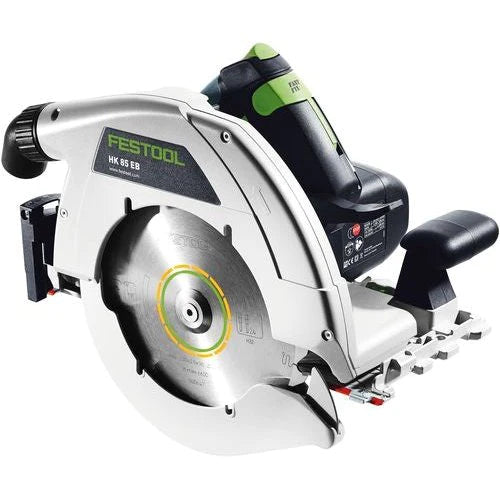
What you need to consider when picking a saw blade:
What saw you have:
[product=new-festool-ts-55-febq-plus-plunge-track-saw-with-fs-1400-guide-rail]
Hello, this is a product embed test
[/product]
What saw you have impacts your blade choice. There are 2 main aspects about your saw that determine what blades you can choose from.
Thickness of blade that it accepts.
Our most popular saw the TS 55 and its cordless brother the TSC 55 have both had an upgrade in the last 2 years that has affected what blades it can use.
The old model TS 55 REBQ and TSC 55 take a 2.2mm kerf blade
The current model TS 55 FEBQ (from April 2021) and TSC 55 KEBQ (from April 2021) take a 1.8mm kerf blade
To figure out what saw you have, look for the label on the body of the saw that contains the serial number and other information of the saw. This label will also contain which exact model you have. If you have trouble finding this, don’t hesitate to give us a call.
Diameter of saw blade that it accepts
Each saw model had a blade diameter requirement. These can be found on the same label that the model number can be found on.
- 160mm dia.
- Festool TS 55
- Festool TSC 55
- Festool HK 55
- Festool HKC 55
- 168mm dia.
- Festool TS 60
- 190mm dia.
- DeWalt DCS577 54V FlexVolt
- 210mm dia.
- Festool TS 75
- 230mm dia.
- Festool HK 85
See below, a table of blade fitment for the Festool 160mm plunge and circular saws.
| Product |
WOOD FINE CUT |
WOOD UNIVERSAL |
WOOD RIP CUT |
LAMINATE/ HPL |
ALUMINIUM/ PLASTICS |
ABRASIVE MATERIALS |
||||||
|---|---|---|---|---|---|---|---|---|---|---|---|---|
| Kerf width | 1.8 mm | 2.2 mm | 1.8 mm | 2.2 mm | 1.8 mm | 2.2 mm | 1.8 mm | 2.2 mm | 1.8 mm | 2.2 mm | 1.8 mm | 2.2 mm |
| Item | ||||||||||||
| ID | 205553 | 491952 | 205551 | 496302 | 205550 | 496301 | 205554 | 496308 | 205555 | 496306 | 205558 | 201910 |
| TS 55 F (from April 2021) |
x | x | x | x | x | x | ||||||
| TSC 55 K (from April 2021) | x | x | x | x | x | x | ||||||
| HK 55 |
x | x | x | x | x | x | ||||||
| HKC 55 | x | x | x | x | x | x | ||||||
| TS 55 R (2012 – April 2021) |
x | x | x | x | x | x | ||||||
| TSC 55 (2014 – April 2021) | x | x | x | x | x | x | ||||||
The Material That You Are Working With:
Wood
- Fine Cut Wood Blade
- Used for cutting MDF, veneered and coated panels like melamine or for achieving a crosscut in solid wood with minimal tearout.
- Generally use the trapezoidal cross cut tooth layout (described below)
- Has a high tooth count which slows the cutting speed down but allows for a finer cut.
- Universal Wood Blade
- Designed for cross cuts in all wooden materials and wooden building panels.
- Generally uses a standard cross cut blade layout
- Has a mid range amount of teeth, allowing for increased cutting speed.
- Rip Cut Wood Blade
- Ideal for rip cuts in solid wood.
- Generally uses a standard cross cut tooth layout
- Has a low tooth count, giving it the fastest cut with less force.
Aluminium
- Aluminium/Plastics Blade
- Used for cutting aluminium panels and profiles
- Generally uses a flat tooth with variable chamfer tooth layout
- Has a high tooth count, requiring slower cutting speed but leaving a tidy edge.
- Slightly negative rake angle for long service life
Plastics
- Aluminium/Plastics Blade
- Used for cutting Perspex (acrylic), hard and fibre-reinforced plastics.
- Generally uses a flat tooth with variable chamfer tooth layout
- Has a high tooth count, requiring slower cutting speed but leaving a tidy edge.
- Slightly negative rake angle for long service life
- Laminate/HPL blade
- Used for cutting Perspex (acrylic) and resin
- Generally uses a trapezoidal/flat tooth layout
- Has a high tooth count, requiring slower cutting but leaving a cleaner edge.
- Slightly negative rake angle for long service life
Laminate
- Aluminium/Plastics Blade
- Used for cutting laminate, coated panels, melamine and resin boards.
- Generally uses a flat tooth with variable chamfer tooth layout
- Has a high tooth count, requiring slower cutting speed but leaving a tidy edge.
- Slightly negative rake angle for long service life
- Laminate/HPL blade
- Used for cutting laminate, coated panels, melamine and resin boards.
- Generally uses a trapezoidal/flat tooth layout
- Has a high tooth count, requiring slower cutting but leaving a cleaner edge.
- Slightly negative rake angle for long service life
Trespa/HPL (High Pressure Laminate)
- Laminate/HPL blade
- Used for cutting Trespa (HPL).
- Generally uses a trapezoidal/flat tooth layout
- Has a high tooth count, requiring slower cutting but leaving a cleaner edge.
- Slightly negative rake angle for long service life
- Aluminium/Plastics Blade
- Used for Trespa (HPL).
- Generally uses a flat tooth with variable chamfer tooth layout
- Has a high tooth count, requiring slower cutting speed but leaving a tidy edge.
- Slightly negative rake angle for long service life
Hardies (Fibre Cement)
- Diamond Saw Blade (DSB) / Abrasive Materials Blade
- Used for cutting abrasive materials like hardies (fibre-cement board), and gypsum bonded chipboard.
- Generally uses a flat tooth layout.
- Has an extremely low tooth count (often 2 or 4)
- Fitted with polycrystalline diamonds (PCD).
See Below for a Quick and Easy Guide:



